In the world of everyday carry pocketknives, there are no shortage of options. And while most manufacturers focus on tactical, or modern styles…one small french company, Opinel has been making the same traditional knife since the late 1800’s.
In this guide, I’m going to give my thoughts on Opinel knives, and where I think they fit into the big picture. Whether you are a knife collector, outdoorsman or craftsman…these simple yet quality knives are worth taking a closer look at.
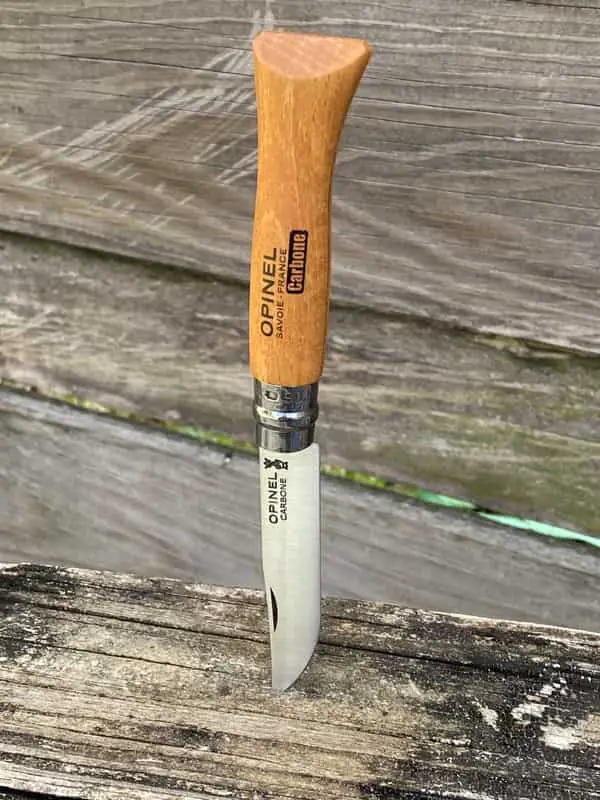
Table of Contents
- So, Are Opinel Knives Good?
- What Are Opinel Knives Used For?
- What Are The Different Types of Opinel Knives?
- Which Opinel Knife Is Best?
- How To Open Opinel Knife
- How To Clean Opinel Knife
- About Opinel Knives
- Conclusion
So, Are Opinel Knives Good?
Opinel knives aren’t just good; they’re well-made and timeless knives that can accomplish most light-medium duty tasks. From the kitchen or picnic prep to garden and outdoor bushcraft, Opinel knives are a great choice for everyday casual use.
Now lets get this out of the way right off the bat…are Opinel Knives good for heavy-duty bushcraft or survival use? No, probably not.
They do not have a heavy blade, nor the backbone and handle to withstand heavy chopping often required in bushfcraft.
Would it work? Yes. But there are much better survival knives if that is specifically what you’re looking for.
There are no fancy features involved in Opinel’s construction design, making them cheap to manufacture – in turn, those savings are passed down to the customer.
For the purposes of this section, I’ll be talking about the classic No. 6. Other models of Opinel knives may, of course, vary widely based on which one you get. I’ll be splitting this into multiple sections that deal with portability, ergonomics, function, and more.
Portability
None of the Opinel knife folders come with a pocket clip. Instead, the blade folds into the round handle, creating a seamless cylinder shape.
I personally find this shape easier to grab out of a pocket, and stores well in the bottom of a tackle box or kit. It’s much easier to pick up, than say a flat handle.
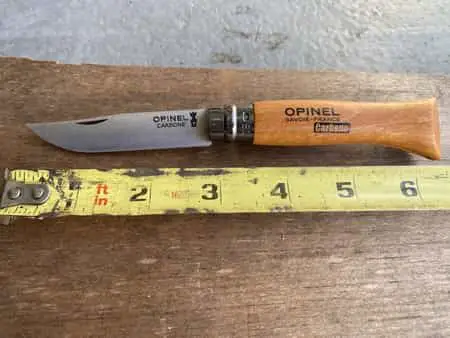
What they lack in size and strength, they quickly make up for in weight. These knives are extremely lightweight, as you can see from their minimalist and simple design. You won’t feel a knife like this swinging around in your cargo pocket or grow tired of its footprint.
It’s a delightful everyday carry (EDC) around the home, farm or shop.
Ergonomics
The No. 6 has a great ergonomic feel in hand. Unlike some modern knives, the Opinel’s handle shape hasn’t changed since it was invented back in 1890. The handle is designed to fill the hand, and it has no finger grooves or slots.
While you may initially think this makes it inferior to knives with slots, it’s just the opposite – you don’t have to bend and strain your fingers when holding the knife. This makes it comfortable to hold for extended periods of time.
The proprietary Virobloc locking ring makes it comfortable to hold the knife in open and closed positions for extended periods – this aspect of the design was allegedly created by Joseph Opinel in a corner of his father’s workshop when working on the knife’s design.
The Blade
Unlike many modern knives with a stainless steel blade, the No. 6 (and all Opinel knives) has a carbon steel blade. The No. 6 has an 8.5-cm (3.3-in) blade. Carbon steel is slightly different from regular or stainless steel, with a couple of key differences that set it apart from the crowd.
Technically, a carbon steel blade just has a much higher carbon content since all knives have carbon in their makeup.
Functionally, this makes it much stronger than a stainless or regular steel blade. Most carbon steel blades are more brittle than regular steel, meaning it’s more prone to shattering under high pressure.
Another important difference is that generally, carbon steel is more difficult to sharpen and doesn’t hold an edge for as long as regular steel. Opinel, though, heat treats its knives and adds chromium to increase the strength of its blades.
Just as important is that the edge lasts for an admirably long time, so you only have to sharpen it once in a while versus every other use.
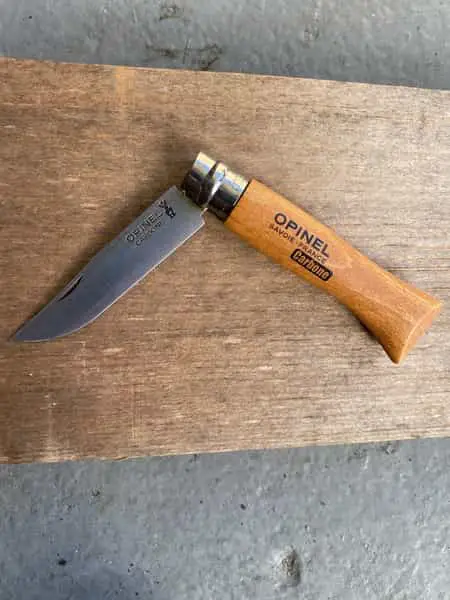
Over time, a carbon steel blade will develop a coating called a patina, which is especially noticeable where you touch the blade with your fingers – your skin oils will help kickstart the creation of this patina.
This patina is normal and actually protects the blade from harmful corrosion such as rust. This is vital to the blade’s longevity because carbon steel is typically more vulnerable to corrosion.
What else is unique about Opinel’s blades is the blade grind, which is the way the knife curves from the point. While many other blades have a relatively flat grind, the No. 6 has a gently curved blade grind.
This makes it ideal for many delicate tasks like slicing fruits or meats, as well as more intensive slicing like cutting rope or vines.
Out of the package, the Opinel has an excellent beveled edge and is razor-sharp.
What Are Opinel Knives Used For?
Opinel knives are commonly used for everyday tasks such as cutting rope, gardening or even slicing vegetables. The larger models, Number 8 and up can withstand more heavy-duty uses such as camp chores, game processing, and bushcraft work.
Opinel Knives get their roots from the everyday working man or women of the late 1800’s. On any given day one could use an Opinel Knife to:
- Cut open a bail of hay
- Prune a grape vineyard
- Cut off ripe vegetables
- Open a mail package
- Slice potatoes, or fillet a fish for dinner
- Cut kindling for firewood
- Carve or widdle a wooden toy
- Shapren stakes for camping
Despite its lightweight size and rounded profile, Opinel Knives are capable of handling most tasks around everyday life.
What Are The Different Types of Opinel Knives?
When people think of Opinel, the classic design with the locking collar and rounded beechwood handle springs to mind.
There are ten basic types of Opine knives, and you can also request custom handles for any of the different varieties. Opinel sells kitchen knives, table knives, outdoor/garden knives, and knives with kid-friendly designs. All of these are designed for their respective uses but with an Opinel twist.
Some of the different wood varieties include wild cherry, ebony, walnut, hornbeam, and more.
The Original Opinel Sizes are:
- No. 2: 3.5 cm (1.3 in) blade, 4.5 cm (1.8 in) handle.
- No. 3: 4 cm (1.6 in) blade, 5.5 cm (2.2 in) handle.
- No. 4: 5 cm (2 in) blade, 6.5 cm (2.5 in) handle.
- No. 5: 6 cm (2.4 in) blade, 8 cm (3.15 in) handle (notably used by Picasso).
- No. 6: 7 cm (2.75 in) blade, 9.5 cm (3.74 in )handle.
- No. 7: 8 cm (3.15 in) blade, 10 cm (4 in) handle.
- No. 8: 8.5 cm (3.3 in) blade, 11 cm (4.3 in) handle.
- No. 9: 9 cm (3.5 in) blade, 12 cm (4.7 in) handle.
- No. 10: 10 cm (4 in) blade, 13 cm (5 in) handle.
- No. 12: 12 cm (4.7 in) blade, 16 cm (6.3 in) handle.
Another interesting offer from Opinel are oversized handles crafted into knives; these are for customers to carve into their unique designs, so no single person ever ends up with the same knife handle.
Not only do Opinel make knives with stainless steel, but they also engrave knives upon request.
Which Opinel Knife Is Best?
Which knife is best for me, may not be the best for you. Knife ownership is subjective, based on the individual and its intended use. However, the Opinel No. 8 is very popular for an ‘all around‘ knife. It’s not too big, nor too small for most tasks.
How To Open Opinel Knife
The traditional way to open an Opinel knife is to hold the knife by the handle with one hand, undo the rotating lock with the other hand, then open the blade. The Virobloc locking collar is twisted to affix the blade in its open position.
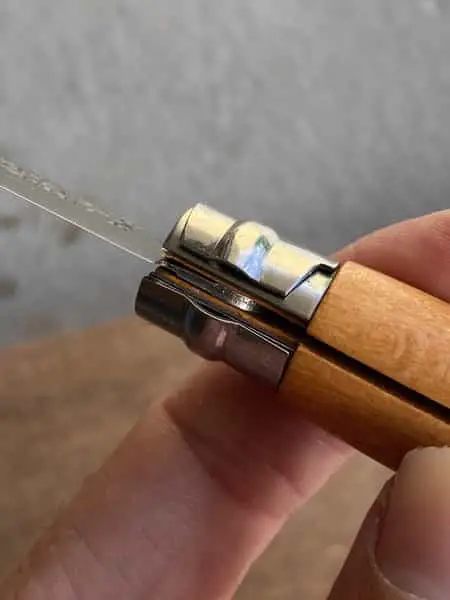
Blade lock open 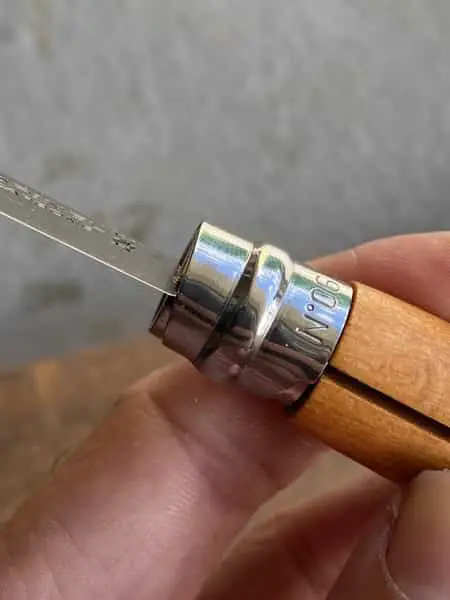
Blade lock closed
How To Clean Opinel Knife
For cleaning a carbon steel Opinel knife, simply:
- Wash the blade with a sponge or rag with soapy water.
- Rinse the sponge or rag and wipe the knife again.
Opinel recommends applying cooking oil to the blade before closing it after cleaning – leaving absolutely no oil on a carbon steel blade accelerates undesirable oxidation.
About Opinel Knives
Opinel knives were invented in 1890 by Joseph Opinel in Savoie, France. They were marketed as a working-class man’s knives, and to this day, their affordable price point stands out. Only seven years later, the knives were so popular that Joseph Opinel created 12 different sizes of the knife – No. 6 is the most iconic of the bunch.
Opinel knives have a striking round beechwood handle, a basic twist-lock mechanism to open and close the knife, and typically a six-inch (15-cm) blade – the exact size of the blade varies based on which knife number it is. A locking collar that’s also called a Virobloc is tightened and loosened to hold the knife open or closed.
The locking collar is a vital part of Opinel knives because the way it tapers makes it operable even after the knife has otherwise worn out.
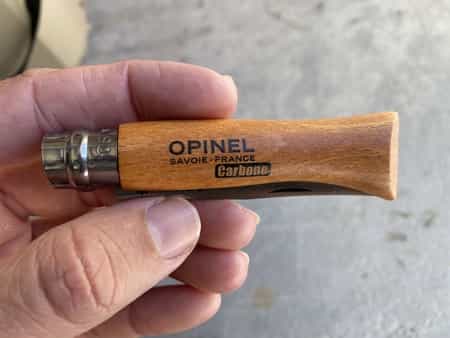
Smaller models of Opinel knives, numbers 2 through 5, notably don’t even have a locking mechanism. Rather, they use the tension created between the knife tang and the handle to hold the knife open.
Opinel knives are dubbed ‘peasant knives,’ which grew from their initial sales to railroad workers in France in the early 1900s. You can order a No. 6 Opinel knife from their website for very cheap, and some other models are even cheaper.
Conclusion
Perhaps the biggest benefit of Opinel knives is their affordability and unique look. They are immediately recognizable and a step back into time. For that reason alone, they make excellent gifts.
However, from a functional standpoint, they are quite worthy and really offer more than one would expect.
They are simple, easy to use, made of quality materials, and fully capable of most tasks.
For me personally, that’s what I look for in a knife. When I’m heading into the wilderness for heavy-duty bushcraft or survival training…ill grab the fixed blade or chopper.
But around the house, on the boat, at the lake, or an evening in the woods the Opinel knife is in fact, really good.
Thanks for reading!
- Neem Oil Deer Repellent: Does It Really Work?

- Is It Okay To Burn Bark In a Wood Stove?
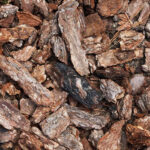
- Do Deer Eat Morel Mushrooms?

- How To Properly Dispose of Wood Stove Ashes (Safely!)
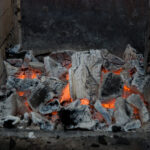
- Is Fatwood Safe for Wood Stoves? Here’s What You Should Know
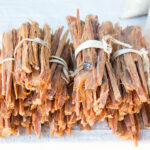
- Is Beaver Good to Eat? You May Be Surprised!
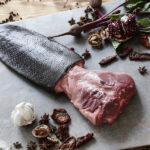
- Is Bread Bad For Deer? Here’s What You Should Know

- Are Roosters Good to Eat?
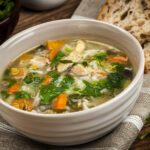
- 3 Easy Ways To Tell If Your Wood Stove Is Leaking
